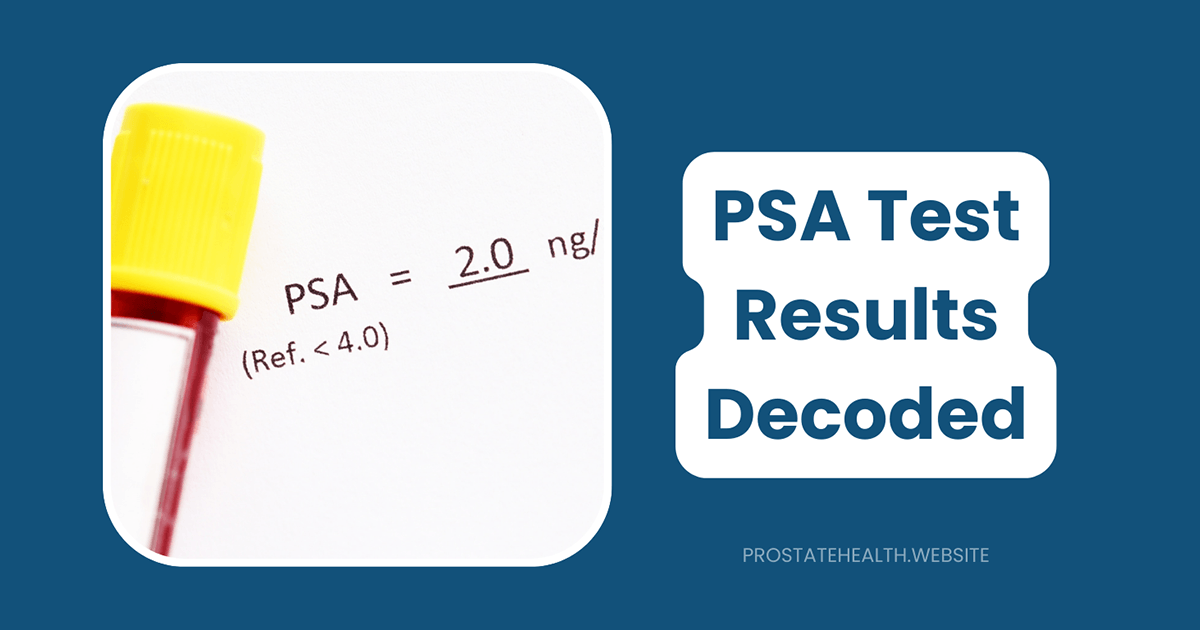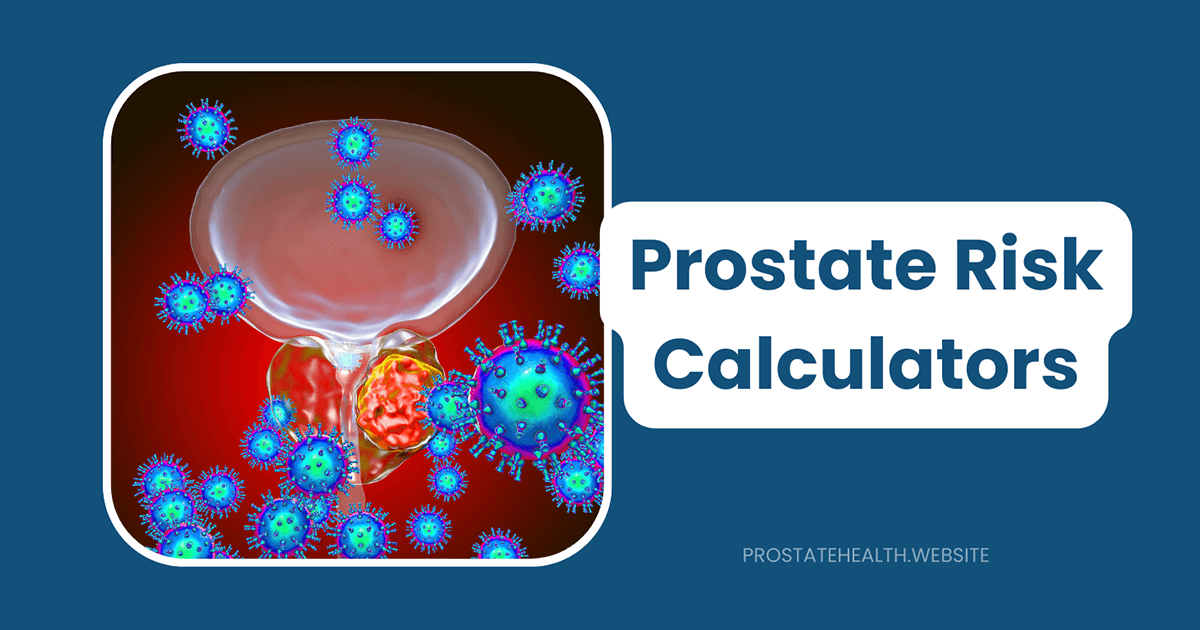Decoding Your PSA Test Results: What the Numbers Mean

Few medical test results generate as much anxiety and confusion as the PSA blood test. Whether you’ve just had your first screening or you’re monitoring levels after treatment, those numbers on your lab report can seem like a mysterious code that holds the key to your future health.
As someone who’s guided hundreds of men through the often murky waters of prostate health, I understand the uncertainty that comes with PSA testing. The good news is that interpreting these results doesn’t have to be overwhelming. With the right knowledge, you can better understand what your PSA numbers mean and have more productive conversations with your healthcare provider.
This guide will help you decode your PSA test results, understand the factors that influence them, and know what questions to ask your doctor about next steps.
What Is PSA and Why Do We Measure It?
Prostate-Specific Antigen (PSA) is a protein produced almost exclusively by the prostate gland. Its primary function is to liquefy semen after ejaculation, helping sperm move more freely. Small amounts of PSA naturally leak into the bloodstream, and these levels can be measured through a simple blood test.
While PSA testing isn’t perfect, it remains one of our most valuable tools for early detection of prostate cancer. Since its widespread adoption in the early 1990s, the prostate cancer death rate has decreased by more than 50% in the United States. According to recent studies, PSA testing is believed to account for 45% to 70% of this reduction.
However, it’s crucial to understand that PSA is prostate-specific, not cancer-specific. Elevated levels can indicate cancer, but they can also result from several non-cancerous conditions.
Understanding the Basic Numbers
When you receive your PSA test results, you’ll typically see a number followed by “ng/mL” (nanograms per milliliter). This measurement tells you how much PSA is circulating in your bloodstream.
What’s Considered “Normal”?
Historically, doctors used 4.0 ng/mL as the cutoff for “normal” PSA levels. However, our understanding has evolved, and we now recognize that:
- There’s no single PSA level that definitively indicates cancer or rules it out
- “Normal” levels vary by age
- The pattern of change over time may be more important than any single reading
Age-Specific PSA Reference Ranges
As men age, their prostates naturally grow larger, which typically leads to higher PSA levels even in the absence of cancer. The 2025 guidelines suggest the following age-specific reference ranges:
| Age Group | Reference Range |
| 40-49 years | 0-2.5 ng/mL |
| 50-59 years | 0-3.5 ng/mL |
| 60-69 years | 0-4.5 ng/mL |
| 70+ years | 0-6.5 ng/mL |
What Different PSA Levels Might Mean
While these ranges provide general guidance, it’s helpful to understand how doctors typically categorize PSA results:
PSA Less Than Age-Specific Reference Range
- Generally reassuring
- Low risk of clinically significant prostate cancer
- Typically warrants routine screening as recommended by guidelines
PSA Slightly Above Reference Range
- Moderately increased risk
- Often leads to additional testing or closer monitoring
- Many non-cancerous conditions can cause slight elevations
PSA 4-10 ng/mL
- About 25% chance of prostate cancer
- Often described as the “diagnostic gray zone”
- Additional tests like free PSA, MRI, or biomarkers may be recommended
PSA Above 10 ng/mL
- Over 50% chance of prostate cancer
- Higher likelihood of clinically significant disease
- Usually leads to recommendation for biopsy or additional imaging
PSA Above 20 ng/mL
- High likelihood of prostate cancer
- Increased risk of locally advanced or metastatic disease
- Immediate evaluation typically recommended
PSA Above 50 ng/mL
- Very strong indicator of prostate cancer
- High risk of advanced disease
- Comprehensive staging workup usually indicated
As Robert, a 62-year-old patient, shared with me: “When my PSA jumped from 2.8 to 6.3 in a year, I was terrified it meant advanced cancer. But after additional testing, we found I had an infection. Once treated, my PSA dropped back to 3.1. That experience taught me that PSA is just one piece of the puzzle.”
Beyond the Basic Number: Advanced PSA Metrics
While your total PSA is important, several other PSA-related measurements can provide additional insights:
Free PSA Percentage
PSA in your bloodstream exists in two forms: “free” (unbound) and “bound” (attached to proteins). The percentage of free PSA relative to total PSA can help distinguish between cancer and benign conditions.
- What it means: Cancer tends to produce more bound PSA, resulting in a lower percentage of free PSA
- How it’s interpreted:
- Free PSA > 25%: Lower risk of prostate cancer
- Free PSA 10-25%: Intermediate risk
- Free PSA 0.15: Higher risk of clinically significant cancer
PSA density has become increasingly important in determining which men with elevated PSA should proceed to biopsy versus continued monitoring.
PSA Velocity
PSA velocity measures how quickly your PSA level changes over time, typically calculated from three or more measurements over 18-24 months.
- What it means: Rapid increases may indicate cancer, while stable or slowly rising levels are more likely due to benign growth
- How it’s interpreted:
- Increase 0.75 ng/mL per year: Concerning for possible cancer
According to the 2025 APCCC Diagnostics Conference, a PSA velocity greater than 0.75 ng/mL per year strongly correlates with increased risk of disease progression.
PSA Doubling Time
PSA doubling time calculates how long it takes for your PSA level to double, which can indicate how aggressive a cancer might be.
- What it means: A shorter doubling time suggests more rapid cancer growth
- How it’s interpreted:
- Doubling time > 3 years: Generally slow growth
- Doubling time 1-3 years: Intermediate growth rate
- Doubling time < 1 year: Rapid growth (concerning)
- Doubling time < 3 months: Very rapid growth (high risk)
PSA doubling time is particularly important for men who have been treated for prostate cancer and are being monitored for recurrence. Recent research presented at the 2025 APCCC Diagnostics Conference showed that men with a PSA doubling time of less than 9 months after treatment have a significantly higher risk of developing metastases.
Factors That Can Affect Your PSA Level
Before assuming an elevated PSA indicates cancer, it’s important to understand that many factors can temporarily or permanently affect your PSA level:
Temporary Factors (May Elevate PSA for Days to Weeks)
- Recent ejaculation: Can raise PSA for 24-48 hours
- Vigorous exercise, especially cycling: May elevate PSA for 24-72 hours
- Digital rectal exam (DRE): Can cause minor elevations for 1-2 days
- Urinary tract infection: Can significantly raise PSA until infection resolves
- Prostatitis (inflammation of the prostate): Often causes substantial PSA elevation
Long-Term Factors
- Benign prostatic hyperplasia (BPH): Natural enlargement of the prostate with age
- Prostate trauma or recent procedures: Prostate biopsy, cystoscopy, or catheterization
- Urinary retention: Can cause PSA elevation until resolved
- Medications: Testosterone replacement therapy can increase PSA; 5-alpha reductase inhibitors like finasteride (Proscar) or dutasteride (Avodart) typically lower PSA by about 50%
As Michael, a 58-year-old patient, told me: “My PSA jumped from 2.1 to 4.3, and I was immediately worried. But my doctor asked if I’d been cycling, and I had just completed a 50-mile charity ride two days before the test. We repeated the test two weeks later, and it was back to 2.2. That taught me how sensitive the test can be.”
What Happens When Your PSA Is Elevated?
If your PSA is above the reference range for your age, don’t panic. Here’s what typically happens next:
1. Rule Out Non-Cancer Causes
Your doctor may:
- Ask about recent activities that could temporarily raise PSA
- Check for signs of infection or inflammation
- Consider the impact of any medications you’re taking
- Possibly treat any identified infections or inflammation
2. Repeat the Test
A single elevated PSA should almost always be confirmed with a repeat test, typically after:
- Waiting 2-4 weeks to allow temporary factors to resolve
- Avoiding ejaculation for 48 hours before the test
- Avoiding vigorous exercise for 48-72 hours before the test
- Stopping any activities that might irritate the prostate
3. Consider Additional Testing
If your PSA remains elevated, your doctor may recommend:
- Free PSA test: To help determine cancer risk
- Prostate MRI: To visualize the prostate and identify suspicious areas
- Newer biomarker tests: Such as the Prostate Health Index (PHI), 4Kscore, or SelectMDx
- PCA3 urine test: Measures a prostate cancer-specific gene in urine
4. Possible Biopsy
If additional testing suggests a significant risk of cancer, your doctor may recommend a prostate biopsy. Modern approaches often include:
- MRI-guided targeted biopsy
- Fusion biopsy (combining MRI and ultrasound)
- Transperineal approach (through the skin between the scrotum and rectum)
PSA After Prostate Cancer Treatment
If you’ve been treated for prostate cancer, PSA monitoring takes on different meanings depending on your treatment:
After Radical Prostatectomy
Since the entire prostate is removed, PSA should become undetectable (typically <0.1 ng/mL) within 4-6 weeks after surgery.
- PSA <0.2 ng/mL: Generally considered no evidence of disease
- PSA ≥0.2 ng/mL with a confirmatory reading >0.2 ng/mL: Defined as biochemical recurrence
- Rapidly rising PSA: May indicate more aggressive recurrence
After Radiation Therapy
PSA typically declines gradually after radiation, often reaching its lowest point (nadir) 18-24 months after treatment.
- Stable low PSA: Suggests successful treatment
- PSA nadir + 2.0 ng/mL: The Phoenix definition of biochemical recurrence
- PSA bounce: Temporary rise in PSA (usually in the first 2 years) followed by decline; a normal phenomenon that doesn’t indicate recurrence
During Active Surveillance
If you’re monitoring low-risk prostate cancer without immediate treatment:
- Stable PSA: Suggests stable disease
- PSA doubling time <3 years: May indicate disease progression
- PSA velocity >0.75 ng/mL per year: Often triggers reassessment
Making Sense of Your Results: A Personalized Approach
While these guidelines provide a framework for interpreting PSA results, it’s essential to remember that PSA interpretation should always be individualized. Factors that influence how your doctor interprets your PSA include:
Your Age and Life Expectancy
The significance of an elevated PSA differs based on age and overall health. For example:
- A PSA of 5.5 ng/mL might prompt immediate investigation in a healthy 55-year-old
- The same value might be monitored without immediate action in an 80-year-old with multiple health conditions
Your Family History
Men with a family history of prostate cancer, particularly in first-degree relatives (father, brothers), may warrant more aggressive evaluation of elevated PSA levels.
Your PSA History
Your PSA trend over time is often more informative than any single measurement. A steadily rising PSA, even within the “normal” range, may be more concerning than a stable PSA slightly above the reference range.
Your Risk Tolerance
Some men prefer a more aggressive approach to elevated PSA, while others are more comfortable with monitoring. This personal preference should be part of the decision-making process.
Questions to Ask Your Doctor About Your PSA Results
To make the most of your appointment after receiving PSA results, consider asking:
- Is my PSA level normal for my age?
- How does this result compare to my previous PSA tests?
- What could be causing my elevated PSA besides cancer?
- Would additional tests like free PSA or an MRI be helpful?
- Should we repeat the test, and if so, when?
- What precautions should I take before my next PSA test?
- What is my PSA velocity or doubling time based on my test history?
- Given my personal risk factors, what’s your recommendation for next steps?
- If we decide to monitor my PSA, how often should it be checked?
- At what point would you recommend a biopsy or other intervention?
The Future of PSA Testing
While PSA testing has been the cornerstone of prostate cancer early detection for decades, the field continues to evolve. Emerging approaches that may complement or eventually replace traditional PSA testing include:
Multi-Parametric MRI
Increasingly used before biopsy to identify suspicious areas and reduce unnecessary procedures.
Liquid Biopsies
Blood tests that detect circulating tumor DNA and other cancer biomarkers may offer more specific detection than PSA alone.
Genetic Risk Assessment
Evaluating genetic predisposition to prostate cancer may help tailor screening approaches to individual risk profiles.
Artificial Intelligence
Machine learning algorithms that analyze PSA patterns along with other clinical data may improve risk prediction.
Conclusion: Knowledge Is Power
Understanding your PSA results empowers you to be an active participant in your healthcare decisions. While elevated PSA can certainly cause anxiety, remember that:
- Most elevated PSA results are not due to cancer
- Even when cancer is present, most prostate cancers are slow-growing and highly treatable
- Modern approaches to prostate cancer detection and treatment are more precise than ever before
- The PSA test, despite its limitations, remains a valuable tool that has contributed to a significant reduction in prostate cancer deaths
As Thomas, a 70-year-old prostate cancer survivor, shared with me: “When my PSA started rising 15 years ago, I was terrified. But understanding what the numbers meant helped me make informed decisions with my doctor. Today, I’m cancer-free and still monitoring my PSA. Knowledge truly is power when it comes to your health.”
By understanding what your PSA numbers mean, you can have more productive conversations with your healthcare provider and make informed decisions about your prostate health.
Have you received PSA results that were confusing or concerning? Share your experience in the comments below to help other men navigating this common but often misunderstood test.






